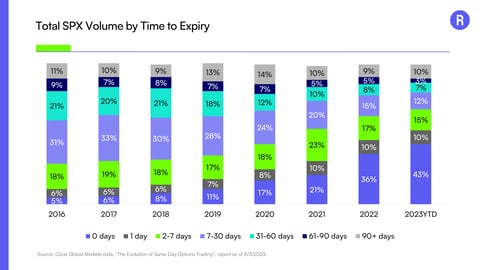Uranium: Powering the Nuclear Revival
Uranium vis-a-vis high school chemistry
To take you back to high school chemistry, uranium is a radioactive chemical element. While it has many uses, such as ammunition and dyes, the one we will focus on today is its use as nuclear fuel. Nuclear energy is created via nuclear fission, a process which takes place within a nuclear reactor. During this process, the nucleus of a uranium atom is split into two, and a large amount of energy is released. So large, in fact, that uranium has much more energy per unit than all other forms of fossil fuels. One pound of uranium generates an equivalent amount of energy as 3 million pounds of coal.1
Uranium vs. solar and wind
Uranium is considered a low-carbon form of energy, and, therefore, a green energy. When an atom is split in a nuclear reactor, energy is released in the form of heat. That heat is then used to create steam, which powers a turbine to capture energy. This is a zero-emissions process, unlike the burning of fossil fuels. Additionally, uranium is an incredibly energy-dense power source, as previously mentioned, and this makes it substantially less wasteful. All of the nuclear fuel produced by the US within the last 60 years could fit within a football field at less than 10 yards deep. Even better, that waste can also be recycled.2
Other energy forms like solar and wind are likely top of mind when thinking about green energy, but their intermittent nature and lack of storability creates gaps in maintaining consistent power usage. This is where nuclear power comes out on top: as a consistent energy source in reducing carbon emissions.
Match made in heaven: uranium and AI
The emergence of artificial intelligence (“AI”) and the data centers that power AI have changed the game for nuclear power. These data centers use an incredible amount of energy. To put it into context, data centers composed 3% of the global energy usage in 2023 - that is equivalent to the energy consumption of Germany. This number is only expected to grow.
To feed the growing electricity demand from AI, nuclear power has become tech’s solution due to its consistent, high energy production. In the last two years, there has been massive investment into nuclear energy plants. Jeff Bezos is backing a Canadian nuclear fusion company, Bill Gates founded TerraPower (a company focused on developing advanced nuclear energy technologies), and Sam Altman (the CEO of OpenAI) has invested in a nuclear energy start up.4 But these investments are not solely occurring on the private-side, the U.S. government is spending billions of dollars to build up a domestic supply of uranium.
100% increase in global investment
Taking you back once again to high school coursework, but this time economics: what happens when massive demand increases in a product are anticipated? Supply must rise to meet demand. This is not an easy solution in commodity markets, as energy production cannot increase overnight. Let’s break down nuclear power and uranium production. The two have very different supply chains: uranium is mined and nuclear power is generated.
While uranium is an energy-dense substance and minimal amounts are needed in nuclear energy production, global uranium mining is picking up in response to demand. One US uranium mining company has opened five new mines in the southwest in the last two years alone.5
Looking at nuclear production, existing nuclear power plants are already operating near capacity year-round. In order to increase production, substantial amounts of capex and time are involved. The average construction time in 2023 to build a nuclear reactor was over 10 years and costs were in the billions.6 However, we have witnessed capex investment into uranium significantly increase over the last 10 years, working to combat this production bottleneck. Between 2015 and 2024, global clean energy investments in nuclear energy have increased 100%.7
Despite large capex investment on both the supply and production side, demand for nuclear energy continues to outpace supply. This supply-demand imbalance has resulted in increased uranium prices. A Canadian-listed Uranium trust, which tracks the spot price of uranium is up 191% since the beginning of 2020.8
The uranium opportunity
With strong demand expected to continue, high capex investment to increase nuclear energy production, and a connection to AI… does uranium have your attention yet?
In January 2025, Roundhill launched the Roundhill Uranium ETF (Cboe BZX: UX) as the first US-listed ETF designed to track the price of physical uranium. This ETF allows retail investors qaccess to a physical uranium investment without needing Jeff Bezos-level-money to buy a nuclear fusion company.
For more information on UX, refer to the fund page.
Exposure Concentration Risk. It is currently expected that the Fund will derive a significant amount of its economic exposure to uranium as a result of swap agreements that reference the Sprott Uranium Trust and Yellow Cake. As a result, the Fund’s performance will be highly dependent on the performance of the Sprott Uranium Trust and Yellow Cake. If, for whatever reason, shares of the Sprott Uranium Trust or Yellow Cake were to be delisted or lose their entire value, Fund Shares would also be expected to suffer a catastrophic loss of value. To the extent that the returns of the Sprott Uranium Trust or Yellow Cake do not match those experienced by the uranium market, the Fund’s returns will correspondingly fail to match such returns. The Fund’s strategy makes the Fund extremely susceptible to issuer-specific events relating to the Sprott Uranium Trust and Yellow Cake that may not necessarily affect the uranium market more broadly. This inherently makes an investment in the Fund riskier than an investment in a fund that provides more diversified exposure. Neither the Fund, Adviser nor Sub-Adviser have conducted due diligence upon the Sprott Uranium Trust or Yellow Cake and make no representations or warranties whatsoever regarding the Sprott Uranium Trust’s or Yellow Cake’s ability to acquire, dispose of or maintain proper custody of uranium. In the event that there is an issue regarding the Sprott Uranium Trust’s or Yellow Cake’s ability to acquire, dispose of or maintain proper custody of uranium, the Fund’s returns will be negatively impacted to a significant degree.
Footnotes
1 Nuclear energy | Definition, Sources, Uses, & Facts | Britannica
2 3 Reasons Why Nuclear is Clean and Sustainable | Department of Energy
3 Energy efficiency predictions for data centres in 2023 | Data Centre Magazine
4 Artificial Intelligence Is Fueling A 'Nuclear Renaissance.' Bill Gates And Jeff Bezos Are In On It. | Investor's Business Daily
5 Production begins at three US uranium mines - World Nuclear News
6 How long does it take to build a nuclear power plant | Statista
7 Nuclear power investments worldwide 2024 | Statista
8 Bloomberg as of 1/30/2025
Investors should consider the investment objectives, risks, charges, and expenses carefully before investing. For a prospectus or summary prospectus with this and other information about Roundhill ETFs, please call 1-855-561-5728 or visit the website at www.roundhillinvestments.com/etf/UX. Read the prospectus or summary prospectus carefully before investing.
Uranium Market Risk. While the Fund does not invest directly in uranium, it will have significant exposure to uranium as a result of derivatives (such as swap agreements) that utilize Spot Uranium, Uranium Companies or Uranium Trusts as the reference asset. Uranium prices are highly volatile due to the interplay of supply and demand dynamics, geopolitical developments, and regulatory changes.
Swap Agreements Risk. The Fund will utilize swap agreements to derive its exposure to the price of uranium. Swap agreements may involve greater risks than direct investment in securities as they may be leveraged and are subject to credit risk, counterparty risk and valuation risk. A swap agreement could result in losses if the underlying reference or asset does not perform as anticipated. In addition, many swaps trade over-the-counter and may be considered illiquid. It may not be possible for the Fund to liquidate a swap position at an advantageous time or price, which may result in significant losses.
Regulatory and Political Risk. Uranium is a heavily regulated commodity due to its use in nuclear energy and potential for nuclear proliferation. Changes in government regulations, international treaties, or geopolitical tensions can significantly impact uranium production, distribution, and consumption.
Environmental and Operational Risk. Uranium mining and processing involve significant environmental and social challenges, including radioactive contamination, water usage, land use conflicts and waste management.
Supply Chain Risk. The uranium supply chain is geographically concentrated, with major production coming from a few countries such as Kazakhstan, Canada and Australia.
Counterparty Risk. Any swap agreements utilized by the Fund will be subject to counterparty risk between the Fund and its swap counterparties. Fund transactions involving a counterparty are subject to the risk that the counterparty will not fulfill its obligation to the Fund.
Concentration Risk. The Fund may be susceptible to an increased risk of loss, including losses due to adverse events that affect the Fund’s investments more than the market as a whole, to the extent that the Fund’s investments are concentrated in investments that provide exposure to uranium.
New Fund Risk. The Fund is a recently organized investment company with a limited operating history.
Non-Diversification Risk. As a "non-diversified" fund, the Fund may hold a smaller number of portfolio securities than many other funds.
Roundhill Financial Inc. serves as the investment advisor. The Fund is distributed by Foreside Fund Services, LLC, which is not affiliated with Roundhill Financial Inc., U.S. Bank, or any of their affiliates.



